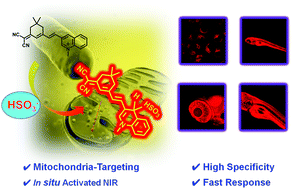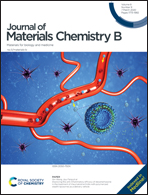A distinctive mitochondrion-targeting, in situ-activatable near-infrared fluorescent probe for visualizing sulfur dioxide derivatives and their fluctuations in vivo†
Abstract
Sulfur dioxide derivatives are intimately involved in some physiological processes in organisms, and high levels of these substances can cause many diseases. Herein, we rationally prepared a mitochondrion-targeting, in situ-activatable near-infrared (NIR) fluorescent probe (DCQN) by coupling 2-(3,5,5-trimethylcyclohex-2-enylidene)malononitrile with 3-quinolinium carboxaldehyde. DCQN displayed a NIR fluorescence turn-on signal to indicate the presence of HSO3−, along with a considerable hyperchromic shift from light yellow to purple via a 1,4-nucleophilic addition reaction. We were able to use DCQN to instantaneously and quantitatively determine the concentration of HSO3− with high specificity, a low detection limit (24 nM), a large Stokes shift (∼110 nm), and a high contrast ratio. Moreover, DCQN displayed good mitochondrion-targeting abilities and was in situ-activated by HSO3− to produce NIR fluorescence for imaging HSO3− in the mitochondria of live breast cancer cells. Furthermore, DCQN was used to monitor HSO3− in zebrafish with a high contrast ratio.

- This article is part of the themed collection: 2020 Journal of Materials Chemistry B most popular articles


 Please wait while we load your content...
Please wait while we load your content...